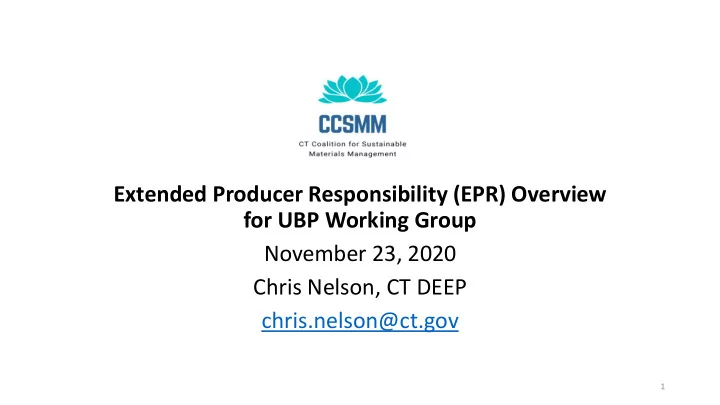

Extended Producer Responsibility (EPR) Overview for UBP Working Group November 23, 2020 Chris Nelson, CT DEEP chris.nelson@ct.gov 1
What is Extended Producer Responsibility (EPR)? • Product Stewardship is the act of minimizing the health, safety, environmental, and social impacts of a product and its packaging throughout all lifecycle stages, while also maximizing economic benefits. The manufacturer, or producer, of the product has the greatest ability to minimize adverse impacts, but other stakeholders, such as suppliers, retailers, and consumers, also play a role. Stewardship can be either voluntary or required by law. • Extended Producer Responsibility (EPR) is a mandatory type of product stewardship that includes, at a minimum, the requirement that the manufacturer's responsibility for its product extends to post-consumer management of that product and its packaging. There are two related features of EPR policy: • (1) shifting financial and management responsibility, with government oversight, upstream to the manufacturer and away from the public sector; and • (2) providing incentives to manufacturers to incorporate environmental considerations into the design of their products and packaging.
CT’s 4 EPR Programs
Fiscal benefits of EPR for Connecticut Municipal Savings • Mattresses - $8,000,000 in avoided disposal costs over 5 years • E-Waste - $6,000,000 in avoided disposal costs since 2011 • Paint - $4,300,000 in avoided HHW costs • Packaging – estimated savings of $40,000,000 per year
Potential benefits of new EPR programs • Municipal savings • HHW, packaging, tires, carpet, others • Properly manage difficult-to-recycle products • Gas cylinders, smoke detectors, sharps, HHW • Reduction in litter/Illegal dumping • Tires, carpet, packaging, marine dumping • GHG reductions, increased recycling, job creation, source reduction, circular economy
Unit-Based Pricing (UBP) is a diversion driver Residents Curbside (or TS) recycling Organics (food scrap & yard wastes) Materials Bottle bill system Remaining trash diverted in for disposal response to UBP Textiles price signal Donations of usable goods Source reduction
Packaging EPR and Unit-Based Pricing programs are complementary • Both UBP (for trash) and Packaging EPR (for single-stream recyclables) programs are recognized as effective policy tools in CT’s Comprehensive Materials Management Strategy (CMMS). • This is not an “Either - Or” proposition - municipalities can pursue both programs to optimize their materials management services.
Recommend
More recommend